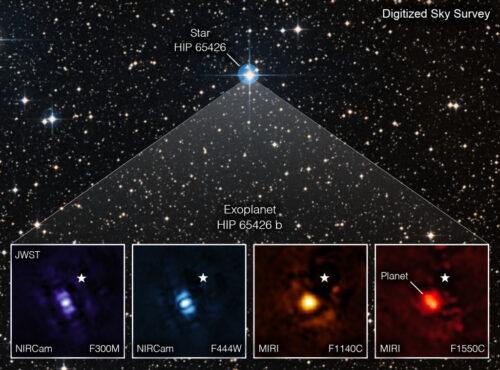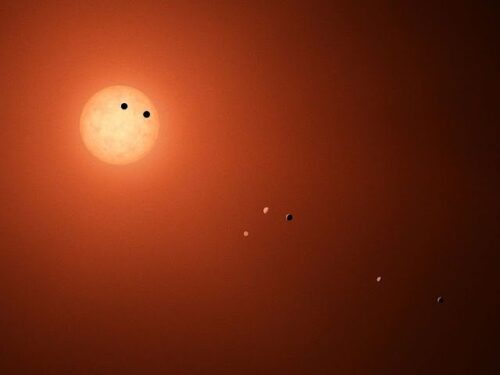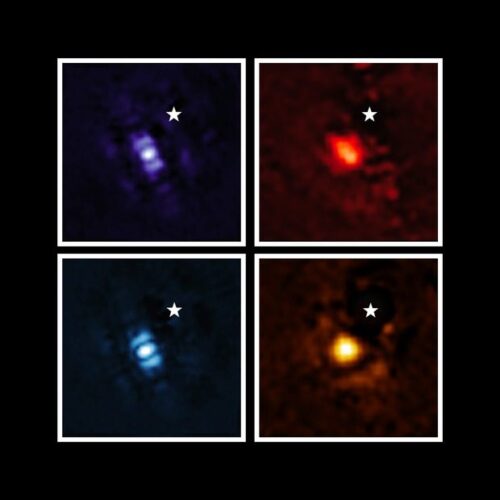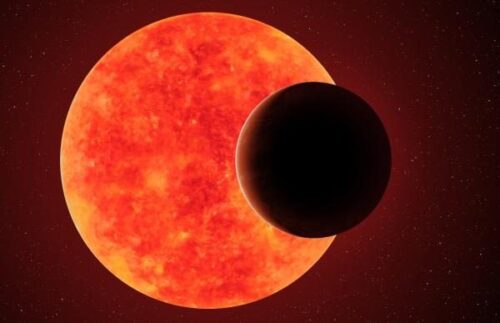
NASA’s Webb Telescope Captures First-Ever Direct Image of Exoplanet
In a groundbreaking achievement, astronomers have utilized NASA’s James Webb Space Telescope to capture a direct image of a planet located outside our solar system.
This exoplanet, identified as a gas giant, lacks a solid surface and is deemed inhospitable for potential habitability.
The image, obtained through four distinct light filters, showcases the remarkable capability of Webb’s powerful infrared technology to observe celestial bodies beyond our own solar system.
This milestone paves the way for future observations that promise to unveil unprecedented insights into the nature of exoplanets.
The captured image provides a view of the exoplanet HIP 65426 b in varying bands of infrared light as seen from the James Webb Space Telescope.
The purple color represents the NIRCam instrument’s perspective at 3.00 micrometers, while the blue shade corresponds to the NIRCam instrument’s view at 4.44 micrometers.
The yellow and red colors reflect the MIRI instrument’s views at 11.4 and 15.5 micrometers, respectively.
Each image features a small white star marking the location of the host star HIP 65426, with the starlight blocked out by coronagraphs and image processing techniques.

It’s worth noting that the bar shapes observed in the NIRCam images are artifacts resulting from the telescope’s optics and not actual objects within the scene.
Sasha Hinkley, an associate professor of physics and astronomy at the University of Exeter in the United Kingdom, who led this international collaboration, expressed that this moment is transformative not only for Webb but for the field of astronomy as a whole.
The James Webb Space Telescope is an international endeavor led by NASA in collaboration with partners ESA (European Space Agency) and CSA (Canadian Space Agency).
HIP 65426 b, the exoplanet depicted in Webb’s image, boasts a mass estimated to be between six to twelve times that of Jupiter, with the observations potentially enabling further refinements in this measurement.
The exoplanet itself is relatively young, around 15 to 20 million years old, compared to our Earth, which is approximately 4.5 billion years old.

In 2017, astronomers discovered this planet using the SPHERE instrument on the European Southern Observatory’s Very Large Telescope in Chile.
However, the images taken by ground-based telescopes only captured short infrared wavelengths.
Webb’s ability to observe at longer infrared wavelengths unveils novel details that would otherwise remain undetectable due to the inherent infrared glow of Earth’s atmosphere.
Researchers are currently analyzing the data from these observations and preparing a paper for peer-reviewed journals.
Nevertheless, Webb’s initial success in capturing an exoplanet image foreshadows the immense possibilities for studying distant worlds.
HIP 65426 b’s significant distance from its host star, over 100 times farther than Earth is from the Sun, facilitated the separation of the planet from the star within the image captured by Webb.
The Near-Infrared Camera (NIRCam) and Mid-Infrared Instrument (MIRI) onboard Webb feature coronagraphs, tiny masks that block starlight, enabling direct imaging of select exoplanets.
NASA’s Nancy Grace Roman Space Telescope, slated for launch in the coming decade, will showcase an even more advanced coronagraph.
Sasha Hinkley expressed admiration for the efficacy of Webb’s coronagraphs in suppressing the host star’s light, considering the immense challenge of capturing direct images of exoplanets due to the stark brightness contrast between stars and planets.

HIP 65426 b appears over 10,000 times fainter than its host star in the near-infrared and several thousand times fainter in the mid-infrared range.
Each filter image portrays the planet as a slightly varying blob of light, a result of Webb’s optical system and its translation of light through different optics.
Aarynn Carter, a postdoctoral researcher at the University of California, Santa Cruz, who led the image analysis, compared the experience of obtaining this image to digging for space treasure.
Through careful image processing, Carter successfully removed the overwhelming starlight to reveal the exoplanet.
While this may not be the first direct image of an exoplanet taken from space (the Hubble Space Telescope previously achieved this feat), HIP 65426 b represents a significant milestone in Webb’s exploration of exoplanets. Carter expressed excitement about the future prospects, noting that countless more images of exoplanets will contribute to our understanding of their physics, chemistry, and formation. It’s even possible that previously unknown planets may be discovered along the way.
